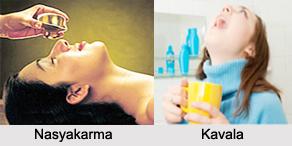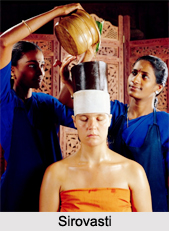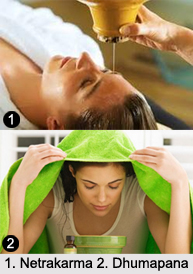 Medicines besides being taken internally, they are also applied in various other ways, such as by injections into the rectum, urethra and female organs; application to the nose; to the mouth; to the eyes to the skin in the shape of plasters, ointments, oils and fumigations, and to the lungs by inhalation. They are briefly discussed below:
Medicines besides being taken internally, they are also applied in various other ways, such as by injections into the rectum, urethra and female organs; application to the nose; to the mouth; to the eyes to the skin in the shape of plasters, ointments, oils and fumigations, and to the lungs by inhalation. They are briefly discussed below:
Vaslikarma are injections into the rectum by means of a tube with a membranous bag tied to its end. The bag was recommended to be made of the bladder of some animal, such as bull, goat, etc. It was filled with the fluid to be injected and tied to one end of a tube, about 8 inches long and with a tapering rounded extremity for introduction into the rectum. Injections into the urethra and vagina were thrown in by similar contrivances, the tubes being adapted in length and thickness to the passages for which they were intended.
Phalavarli are suppositories which were recommended to be made of the size of the patient"s thumb. They were smeared with clarified butter and introduced into the rectum.
Nasya is the application of medicated substances to the nose forms a prominent feature of native therapeutics. 2 primary classes of medicines for this organ are recognized, namely;
•Sirovirechana or medicines causing a flow of secretion from the nose and thus relieving cerebral congestion, and
•Vrinhana or medicated oils applied to the nose with the object of cooling the bead and relieving affections of the neck and chest.
For clearing the head and promoting discharge from the nose, the expressed juice of pungent drugs is poured into thence, drop by drop, or powders are blown into the nostrils by means of a tube. The former process is called "Avapida" and the latter, "Pradhamana" for cooling the head and relieving affections of the upper part of body, various medicated oils are used. In one form of oil called "Pratimarsha", two or three drops of medicated oil are directed to be snuffed up the nostril till they reach the throat, when they should be expectorated and not swallowed. In another form of application called Marsha about a drachma of oil is recommended to be gradually poured into each nostril from a spoon or shell.
 Kavala are the liquids used as gargles. Sometimes a mixture of liquid and solid substances or solid balls of medicine are taken into the mouth and retained in it till they bring on a discharge from the nose and eyes. This mode of application is called "Gandusha". When powders or thick solutions are applied to the teeth and gums with the finger, the process of medicament is called "Pratisarana".
Kavala are the liquids used as gargles. Sometimes a mixture of liquid and solid substances or solid balls of medicine are taken into the mouth and retained in it till they bring on a discharge from the nose and eyes. This mode of application is called "Gandusha". When powders or thick solutions are applied to the teeth and gums with the finger, the process of medicament is called "Pratisarana".
Sirovasti are applications to the head. Oils or other fluids are applied to the head in four different ways. The first form called "Sirovasti", consists in tying a piece of leather in breadth all round the head, luting its lower margin to the skin by a paste of pulse called "mashakalaya" and then filling the cavity thus formed on the top of the head with lukewarm oil. The oil is directed to be retained till relief of pain or till there is discharge from the eyes and nose. It should then be removed and the head washed with warm water. This sort of medication is said to be useful in severe headache and shaking of the head. In the second form, oil or other fluid is poured in a stream on the head. This is called "Parisheka". In the third form, called "Pichu", cotton soaked in oil is applied to the scalp; and in the fourth, called "Avyanga", the oil is simply rubbed on the head.
Applications of liquids and medicated oils to the ears are used in diseases of the head as well as of the ears. The external meatus is filled with the fluid which is allowed to remain in it from 1 to 20 minutes and is then withdrawn.
Netrakarma are applications to the eyes receive various names according to the nature of the substances used and the manner in which they are applied. Pouring of drops into the eyes is called "Aschotana". A poultice enclosed within a piece of cloth and applied over the lids is called "Pinda". A paste applied to the lids is called "Vidalaka". Medicines applied to the margin of the lids or to the conjunctiva with the finger or a metallic probe are called "Anjana".
 Applications to the skin consist of ghritas, oils, plasters, poultices, baths and hot applications for inducing perspiration. Medicated ghritas and oils have been already described. They are for the most part rubbed all over the body, except those intended for local ailments. Plasters called "Pralepa" are applied moist and cold. "Pradeha" or poultices are applied moist and hot. They are also thicker than plasters.
Applications to the skin consist of ghritas, oils, plasters, poultices, baths and hot applications for inducing perspiration. Medicated ghritas and oils have been already described. They are for the most part rubbed all over the body, except those intended for local ailments. Plasters called "Pralepa" are applied moist and cold. "Pradeha" or poultices are applied moist and hot. They are also thicker than plasters.
Dhumapana are inhalations. Tapers or pastilles made of medicinal substances are set fire to, and their fumes are inhaled through a tube by the mouth or nose. In affections of the throat and chest, inhalation through the mouth is recommended, while in diseases of the head, eyes or nose, the fumes are drawn in through the nose. The tube for inhalation may be metallic or made of wood or ivory. The shorter tubes are used in administering expectorant and emetic fumes; inhalations are useful in cough, asthma, catarrh, pain in the neck or head, etc. They may be used for soothing the air passages, for promoting discharge from them, for the relief of cough, or for inducing vomiting. Another form of inhalation, called "Samana", is recommended to be used daily after washing the face, bathing, breakfast, etc.
Dhupana are fumigations which were employed for ulcers and skin diseases. The pastilles for these are made as for inhalation. They are lighted and placed inside two earthen pots, placed face to face. A hole is made in the upper pot and a tube adjusted to it. The free or open end of the tube is now directed to the affected part and the fumes allowed to spread over it. Incenses and tapers composed of various medicinal substances are also burnt in rooms occupied by the sick, for removing unpleasant smells and supposed evil spirits.
Ksharakarma are caustic applications. The ancient physicians of India, like their modern representatives, preferred opening abscesses by caustics, to incising them with the lancet. Hence caustics were described as superior to the lancet, inasmuch as, in addition to opening abscesses, they purified them by removing the derangement of the humours. The part where the caustic is to be applied should first be cleaned and rubbed. The caustic should then be applied with a probe. It should be allowed to remain in contact with the skin for some time and then removed. Caustics are applied to external piles, sinuses, fistulae, abscesses, warts, tumours, leprous patches, etc.
Related Articles
Ayurveda
History of Ayurveda
Origin of Ayurveda
Ayurveda Medication
Principles Of Ayurveda
Elements of Ayurveda
Concepts of Ayurveda
Branches of Ayurveda
Ancient Literature of Ayurveda
Asava and Arishta





